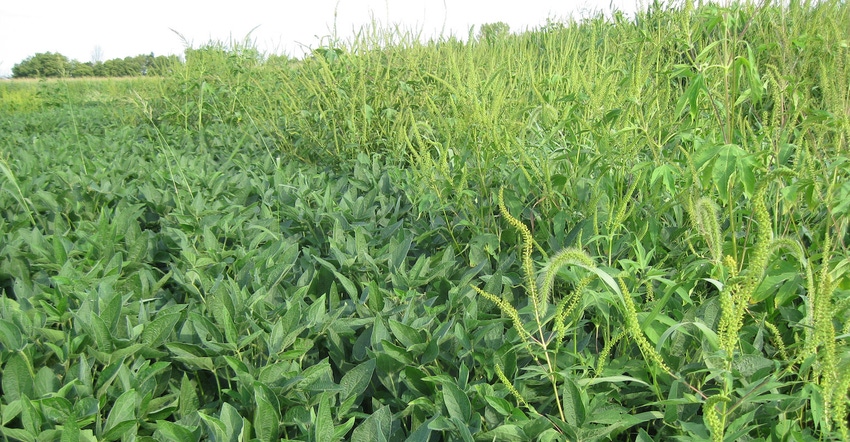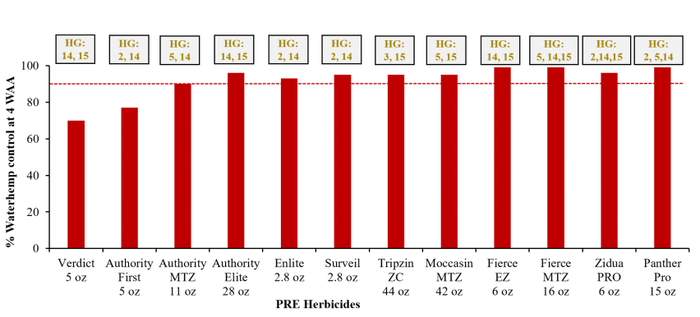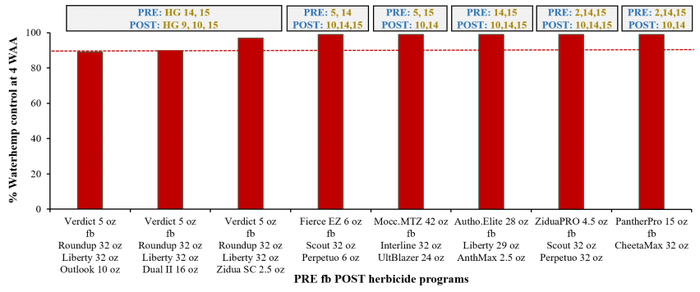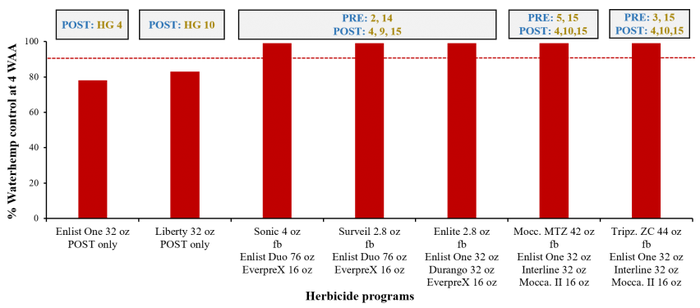January 6, 2021

Waterhemp is a dioecious (male and female flowers on separate plants) pigweed with a high genetic diversity. Consequently, this pigweed has a high propensity to adapt to control tactics and has evolved resistance to herbicides from as many as 6 or 7 different herbicide groups (HGs). Out of 75 waterhemp populations collected from corn/soybean fields in Iowa in fall 2019, almost 25% had a four-way multiple resistance to HGs 2 (ALS inhibitors), 5 (atrazine), 9 (glyphosate), and 14 (PPO inhibitors). It is important to use a diverse herbicide program with multiple, effective sites of action to reduce overreliance on any single herbicide and slow further development of herbicide resistance in waterhemp.
Below are some of the results from recent weed control trials for waterhemp management in soybean conducted by the ISU Weed Science program in Iowa.




There is a little difference among PRE products (Figure 1) when appropriate rates are used. Based on Figures 2 and 3, with an effective PRE followed by an effective POST program (two-pass layered residual, with multiple sites-of-action herbicides), there were no significant differences in waterhemp control (≥90%; red dotted line) in soybean. For instance, when Verdict PRE at 5 oz/a (70% control) was followed by Liberty (glufosinate) + HG 15 POST, waterhemp control increased to 90% or more. A slight difference in % control observed between the HG 15 herbicides (Outlook, Dual II, vs. Zidua with Roundup + Liberty POST) in Figure 2, could possibly be a rate response.
There is an increased selection pressure for HG 15 used in both corn and soybean. Waterhemp populations with resistance to HG 15 have been reported in the Midwest (not in Iowa yet). Since herbicides from this group are the only ones labeled for use in POST residual programs in soybean, it is recommended to use alternative sites of action including HGs 3, 5, and 14 in conjuction (tank mix/premix) with HG 15 in PRE/burndown programs in the spring (Figures 1, 2, and 3).
2,4-D choline (Enlist One) or glufosinate (Liberty) applied alone POST provided inadequate control (<90%) of waterhemp (Figure 3). In contrast, 2,4-D choline and glufosinate (Interline) applied as a tank-mixture provided superior end-of-season control of waterhemp in Enlist E3 soybean. This strategy (multiple sites of action) is one of the best management practices to delay resistance and preserve the utility of 2,4-D choline and glufosinate for waterhemp control. While these programs evaluated a limited number of available postemergence herbicides, the same principles apply to dicamba-based herbicide programs for Xtend (tolerance to glyphosate and dicamba) and XtendFlex (tolerance to glyphosate, glufosinate, and dicamba) soybeans available for 2021.
Waterhemp has an extended emergence period (May through August in Iowa). Waterhemp grows more rapidly than most weeds prevalent in Iowa soybean fields — up to 1 to 1 ¼ inches per day. Therefore, timing of herbicide applications is critical. Furthermore, a high percentage of waterhemp plants can emerge late in the season (at or after V5-V6 stage of soybean). Plants that emerge or survive under the soybean canopy most likely don’t contribute to crop yield reductions; however, those plants can add several thousand seeds (waterhemp being a prolific seed producer) to the soil seed bank. This warrants the need for a season-long management of waterhemp to prevent any seed bank additions using a diversified approach.
Disclaimer: This article is for education purpose only. Mention of a specific product should not be considered as approval, nor should failure to mention a product be considered disapproval. Read the product label before using any herbicide product.
Source: Iowa State University, which is solely responsible for the information provided and is wholly owned by the source. Informa Business Media and all its subsidiaries are not responsible for any of the content contained in this information asset.
You May Also Like




